One path to decarbonization is decentralization
Communities and industries across the globe depend on decentralized power generation to ensure the availability and security of supply. As the world moves toward decarbonization, energy generation systems are increasingly turning to small-scale turbines or engines operating on gas and hybrid solutions with renewables as a cleaner, intermediate step toward a truly sustainable future.
By Ward Pincus
For decades, power grids have been structured in a hub-and-spoke model, with a few large centralized power-generating plants providing electricity to a huge consumer base connected via long transmission and distribution lines. The idea was that the larger you build the plant, the more efficient the electricity system.
For a long time, that logic held true. But with the urgent need to pursue decarbonization, the large increase in intermittent renewable energy on the grid, the still-expensive nature of energy storage, declining costs of decentralized generation, and
the need for greater grid resiliency, decentralized power generation is increasingly recognized as a crucial tool during the energy transition.
Decentralized generation takes many forms – no surprise, given the many needs it serves. These include off-grid electricity for rural and island communities; reliable, high quality power for remote off-grid industries such as mining; and peaker plants to ensure the stability of grids that have a large share of renewable energy generation capacity.
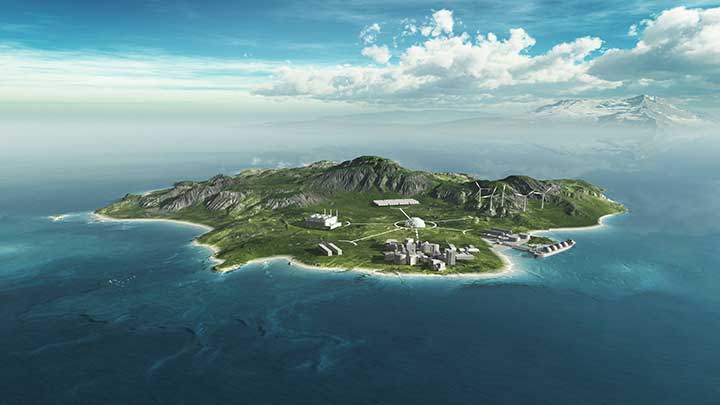
Decentralized power generation offers great potentials in supplying remote regions and islands with stable and sustainable energy
Independent supply for industrial applications
One of the most common uses of decentralized generation are plants in the 50 MW to 100 MW range that serve a single manufacturing plant or industrial park in a remote location. Across the Americas and Sub-Saharan Africa, as well as Asia, these plants are located in areas without grid access or with low-quality access, or in situations when it is beneficial to have their own captive supply of reliable power.
In North America, data centers are increasingly using decentralized generation to meet their enormous energy needs, while some customers and communities in North America and beyond are exploring decentralized generation as a way to improve the resiliency of power infrastructure in the face of hurricanes, floods and fires. Thorsten Dradrach, Head of Sales Power Plants, Americas at MAN Energy Solutions says, “Partners such as the military, coastal communities and industrial complexes will look for their own power generation that they can place right next to their consumption.”
In South America, Australia, Sub-Saharan Africa and parts of Asia, these plants are often serving industries such as mining, textile manufacturing, cement manufacturing, and fish processing. “The large electrical motors and reactive power needs of these industrial operators and other off-takers require stability and security of supply,” something that renewables alone can’t provide, says Waldemar Wiesner, Head of Sales Power Plants, Middle East and Africa at MAN Energy Solutions.
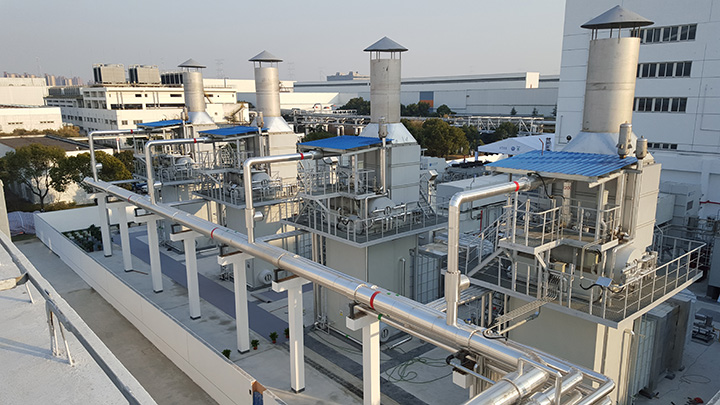
Powered by four sets of MGT 6000 gas turbines from MAN Energy Solutions, a gas-fired combined heat and power plant in Shanghai, China is powering a nearby automotive factory, while saving 59,000 tons of CO2 emissions each year.
That’s why most of these legacy plants are conventional thermal plants powered by fossil fuels. However, many newer plants are incorporating hybrid technologies. The fuel savings from such hybrid plants can be substantial, says Martin Höhler, Head of Sales Power Plants, Asia at MAN Energy Solutions. “You can switch off the power plant during the day or when there is a lot of wind. Your fuel consumption can decrease by up to 30 percent, which could offset your additional investments within maybe three years.”
Dual-fuel gas engines or small-scale gas turbines are often the technology chosen for new plants, either to burn natural gas exclusively, or if natural gas isn’t yet available, to burn liquid fuels until gas infrastructure is available. Longer term, hydrogen or synthetic natural gas produced using renewable energy, can be used – thereby reducing CO2 emissions to zero. In other instances, those with existing thermal plants are adding a renewable component, as a way to reduce operating expenses and CO2 emissions.

The MAN power plant experts, from left: Dr. Tilman Tütken, Head of Sales Power Plants, Europe, Business Unit Power Plants; Waldemar Wiesner, Head of Sales Power Plants, Middle East and Africa; Martin Höhler, Head of Sales Power Plants, Asia; Thorsten Dradrach, Head of Sales Power Plants, Americas
Supplying remote regions
Small island communities, such as those in the Caribbean, the Philippines and Indonesia, also need decentralized energy, since, by definition, they can’t be connected to larger grids, says Höhler. These communities are looking to build small-scale liquefied natural gas (LNG) fueled power plants of up to 50 MW that are “dual-fuel capable,” so they can burn liquid fuels today, and cleaner-burning LNG, once this fuel becomes available to these island communities.
These power plants can also be connected to on- or offshore bunkering systems, storage tanks and regasification systems, enabling them to receive regular LNG shipments from vessels that shuttle supplies from a big terminal to the islands. The small-scale LNG fueled power plants also can be configured as hybrid systems, by incorporating renewables to help reduce fuel consumption and lower emissions.
Such sophisticated microgrids can run on renewables when available and store excess energy in batteries, while the conventional generation via LNG fueled power plants provides security of supply, and the entire system is run by a smart energy management system.
In Africa, off-grid solar is playing a major role in bringing electricity to communities, Wiesner says. “Africa in general is moving really fast, with decentralized solar PV growing much more than conventional power generation. This is mainly for villages and at a very small scale – we are talking about 1 MW to 5 MW.” A report from the World Bank and GOGLA, the global association of the off-grid solar energy industry, says that off-grid solar will provide electricity to 823 million users globally by 2030.
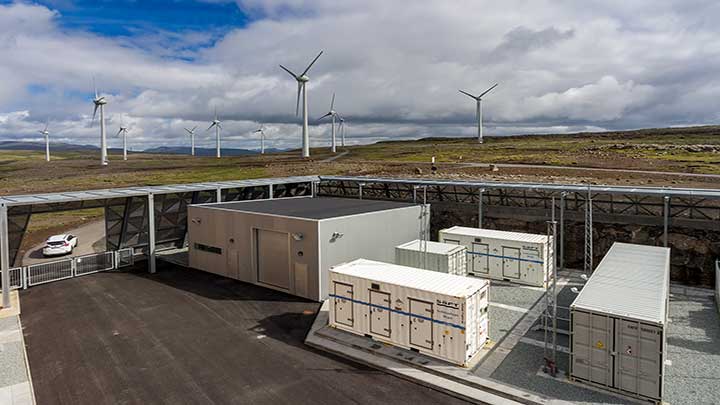
The hybrid energy system installed on the Faroe Island is a role model for remote areas all over the word. It integrates renewable energies with intelligent energy storage solutions and is backed up by highly efficient power plants.
Combined heat and power
One of the most interesting decentralized systems uses CHP technology. A power plant, which can include renewables but principally includes a conventional thermal power technology, generates electricity and heat combined with very high efficiency rates. The heat is distributed to an off-taker, which could be residential developments, desalination plants or manufacturers. The result is a system efficiency of as much as 95 percent.
“Because heat networks are expensive, CHP systems typically operate on a municipal level, with off-takers such as industrial applications nearby, or in the district heating networks of larger towns,” says Dr. Tilman Tütken, Head of Sales Power Plants, Europe at MAN Energy Solutions, adding that CHP plants in Europe generally range in capacity from 7 MW to 100 MW.
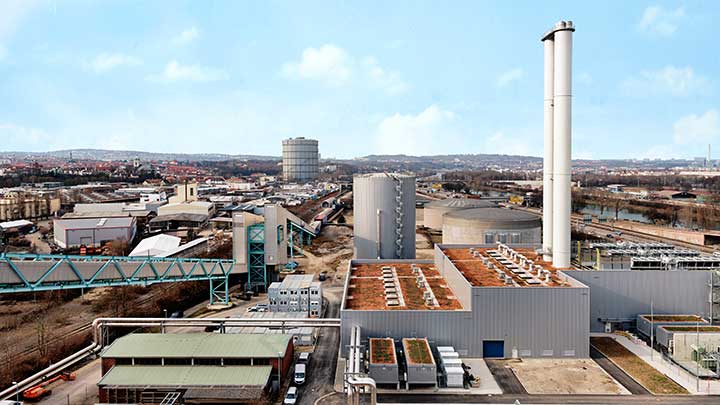
A combined heat and power (CHP) plant in the Gaisburg district of Stuttgart (Germany) is not only producing 30 MW of electrical power, but also supplying 25,000 households with heat at a total efficiency of up to 90 %.
Peaker plants
In markets such as Europe, Australia, and parts of North America, including California – where significant renewable power has been installed, decentralized generation can play a crucial role in grid stabilization. These conventional-technology power plants of a couple hundred megawatts are able to step in to provide capacity, since “the sun doesn’t always shine; the wind doesn’t always blow, and it’s not a gradual process when the sun stops shining or wind stops blowing,” says Houston-based Dradrach.
While battery energy storage solutions can provide grid balancing over very short periods, they are expensive to scale up, Tütken explains. On the other hand, gas-fired plants can ramp up and down quickly and efficiently; they do not require charging, and “they are still the cheaper option and the more environmentally friendly one (compared to liquid fuels or coal) to meet demand when the renewable energy is not there.”
To maximize the efficiency of such systems, countries such as the United Kingdom have established markets for this spare capacity, where “capacities are auctioned, thereby setting a price and quantity defined to supply,” says Tütken.
Decentralization challenges
While some countries, such as Australia and those in Europe, have implemented policies to encourage or mandate hybrid-decentralized generation, most of the world has not. That makes selling lower-carbon solutions more difficult, says Singapore-based Höhler. “It’s not always an economical decision to say ‘yes’ to a hybrid or smaller microgrid project, with no long-term proof and nobody wanting to be the first mover. So what would help is a push from the governments.”
Wiesner, based in Dubai, notes that this could include policies that don’t assume large centralized generation and adapt to a more distributed approach to meeting baseload requirements. This has the benefit of reducing transmission losses and investments and, for Dradrach, creating a more resilient power system.
The complexity of decentralization is a challenge for the sector, Dradrach adds, whether for a large grid with lots of renewable power, conventional plants and peaker plants, or for small microgrids and CHP community systems that need advanced software to manage the multiple supply and demand variables. “These hybrid systems require lots of software, intelligent algorithms, and smart programs.” Höhler adds that it can be a challenge to convince developers and governments familiar with single-technology plants that the benefits outweigh the added complexity.
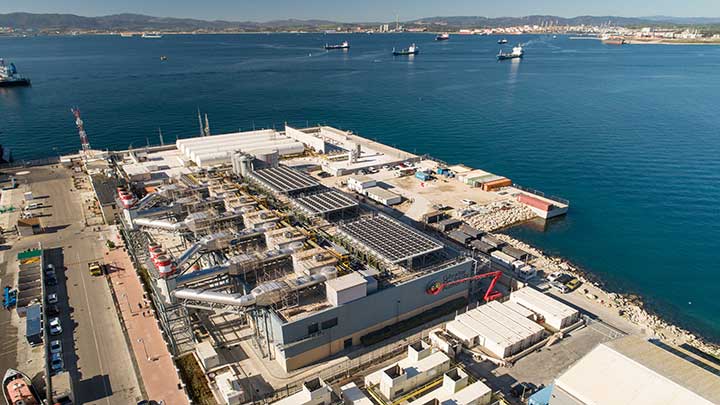
Powered by three MAN dual-fuel engines and fueled by LNG, the North Mole power station forms the backbone of Gibraltar’s energy supply. The power plant is connected to an LNG-terminal ensuring a stable supply with the low-emission gas fuel.
Dynamic transition
What’s clear is that decentralized generation is playing an important role in moving communities large and small toward a more sustainable future, as engineers and scientists develop the technologies that will decarbonize the global economy.
“The technologies we have right now are sufficient to drive the next 30 years, and give us enough time to develop new more environmentally friendly technologies,” says Dradrach. There’s no doubt this is an exciting time for the power sector and decentralized generation in particular. Dradrach concludes, “This is the most dynamic phase in power generation that I’ve seen during 30 years working in this industry − an industry that has the reputation of being quite conservative".
“The technologies we have right now are sufficient to drive the next 30 years, and give us enough time to develop new more environmentally friendly technologies”
About the author
Ward Pincus is a writer based in Dubai covering energy, healthcare and technology issues across the Middle East.
Discover more stories on Decentralized Generation
Explore more topics
MAN Energy Solutions is now Everllence.
We have adopted a new brand name and moved to a new domain: www.everllence.com. This page will also be relocated there shortly. We are working on shifting all pages to www.everllence.com.
